What is a Semi-Automatic Packer and How Can It Improve My Packing Process? [+ VIDEO]
If you’re looking for ways to improve your folder-gluer’s productivity, increase your folder-gluer’s output, and reach higher speeds, you’re probably...
10 min read
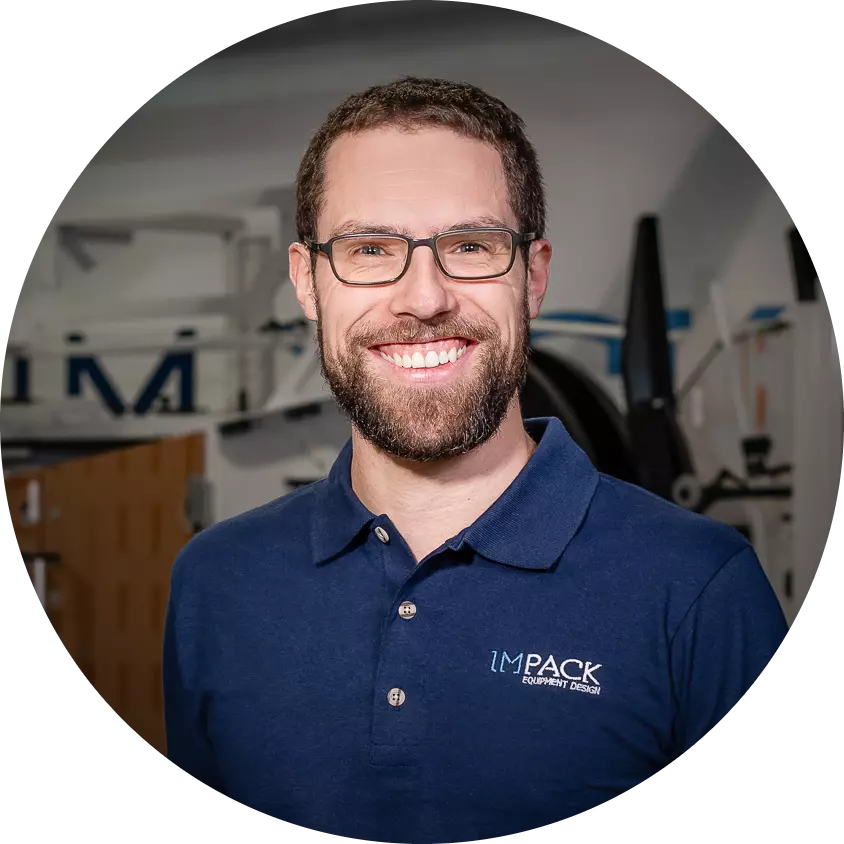 Stefan Badertscher
:
April 29, 2022
Stefan Badertscher
:
April 29, 2022
![Folder-Gluer Packers: What Level of Automation Is Right for You? [+VIDEO]](https://impack.ca/hubfs/X22-039-1.png)
Are you considering investing in a folder-gluer packer or folder-gluer stacker?
Looking for ways to improve your folder-gluer productivity, increase your folder-gluer output, and reach higher packing speeds?
If you said “Yes,” then you found yourself just in the right place!
“What packing systems does IMPACK offer?”
“How do we choose the best packing system that fits our folder-glue r’s production?”
“And how much will a packing system cost us?”
Hi, my name is Hani Hallal. As a Marketing Project Manager here at Impack packaging, I cannot tell you how many times I see clients reaching out to us with those same three questions. This happens dozens of times a week in one form or another.
This article + VIDEO covers the 4 main levels of automation that every packing system on the market falls into and how to choose the right level of automation for your case packing process.
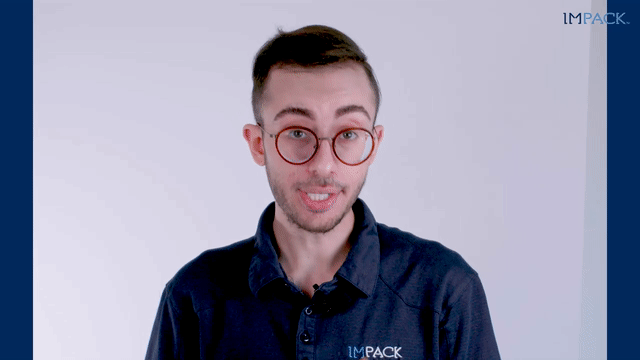
🔍 Recommended: Compare IMPACK’s 3 main machines “Ergosa Vs. Virtuo Vs. Everio” to discover which machine is right for you.
You see, choosing the best packing system that fits your folder-gluer’s production and budget is important. But, what is more important is determining the right level of automation for your end-of-line process.
After all, determining the right level of automation for your case packing process is what allows you to know what machine is best for your production and what options/modules you would need, which would thereby give you an accurate picture of how much a folder-gluer packer or stacker could cost you.
So, determining the right level of automation for your company should be the first step you take.

There are 4 main levels of automation that all packing systems in the world can be classified into.
Before I define each level of automation, it is noteworthy to mention that those are our own definitions and not dictionary definitions. Each level of automation consists of a wide range of packing systems with varying features, benefits, and capabilities.
However, those definitions are informally embraced as industry standards, and most solutions on the market squarely fit within one of those four levels of automation.
Manual packing is the lowest level of automation and usually the starting point of a folder-gluer operation.
It is the traditional packing method used for decades where the whole case packing process is done manually. No automation is involved and no case management is involved in the Manual packing process.
The most common packing systems in the manual category are Collecting Tables.
Bobst’s Handypack GT, KBA Duran's Omega Pack Station, and Tünkers' FAS 480 are some examples of the most popular Collecting Tables in Western countries.
At IMPACK, our Collecting Tables are the “Packing Help Stations.”
The first image below displays IMPACK’s “Packing Help Station 1.0” which consists of an accumulation conveyor and an actual tilting table combination.
-1.webp?width=624&name=ezgif.com-gif-maker%20(67)-1.webp)
And the second image below shows IMPACK’s “Packing Help Station 2.0” which is similar to the other Collecting Tables on the market.
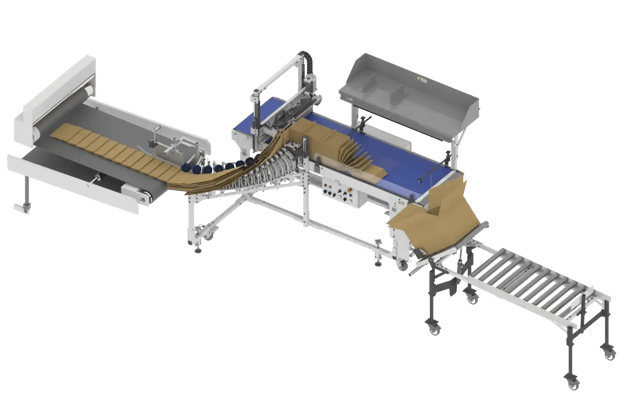
Collecting Tables are Manual packers (non-automated packers) that serve as a packing help/aid to the Manual packing process.
That is, they are very basic packers and still require 100% manual work from your operators, unlike a fully-equipped folder-gluer packer.
🔍 Recommended: Interested in learning more about Collecting Tables and what companies they are best suited for? Check out the article “What is a Collecting Table and How Can It Improve My Packing Process?”
Packing systems that fall in the lowest end of the manual category are ones where you see multiple operators packing directly at the end of the folder-gluer's compression belt.
In other words, they would crowd a bunch of operators/packing staff at the end of the folder-gluer’s compression belt and ask them to pack as fast as they can. This is inefficient, non-ergonomic, and unproductive. Fortunately, we rarely see this happening anymore.
An example of this that we saw in one of our client visits is shown in the image below:
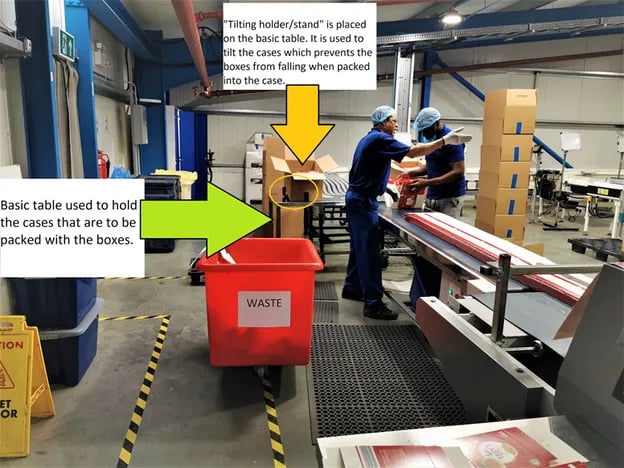
The most popular Collecting Tables on the market all have a right angle on the left or the right with a box turning feature and some form of tilting table (whether a basic table or an actual tilting table).
Some offer more capabilities than others. Ask your packaging equipment supplier about their tilting table’s specifications and level of automation.
But just like with the traditional manual packing process, you still have to pack your boxes by hand on the Collecting Table and do the case flap closing, taping, and ejecting yourself. It is full manual work with no case management involved.
This is all to say that Manual packing is the lowest level of automation and the packing systems that fall into this category (such as Collecting Tables or IMPACK’s Packing Help Stations) involve full manual work, have no automation, no case management, and they just serve as a packing help/aid to your Manual packing process.
Now that we’ve clearly defined the Manual packing process, let’s dive into the next level of automation right above Manual packing: Semi-Automated packing.
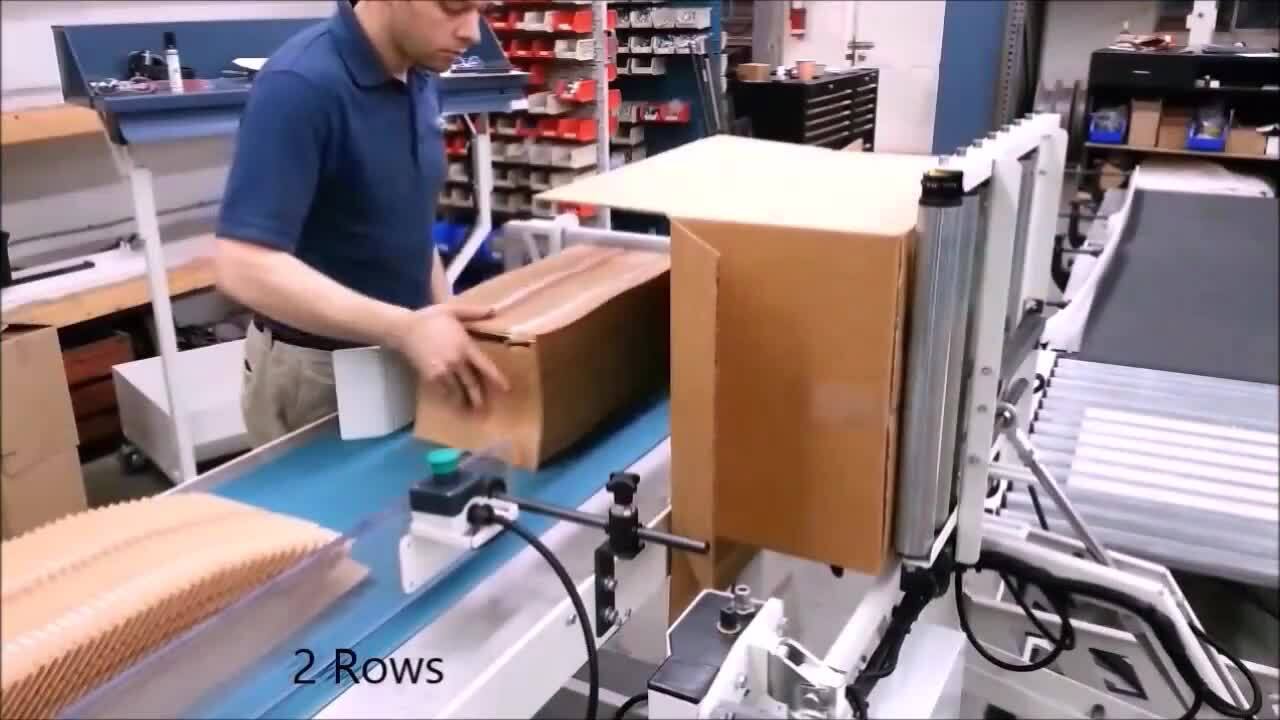
Semi-Automated packing is a packing process that includes at least one automated function.
So, a Semi-Automatic packer is a packer that partially automates your case packing process. Hence the name, Semi-Automatic.
This means that the operator of a Semi-Automatic packer or stacker remains the key factor of the case packing process, but with the help of at least one automated feature.
For example, IMPACK’s Semi-Automatic packer is the Ergosa packer. The automated feature in the Ergosa packer that makes it semi-automated is the Ergosa's case management system.
That is, the Ergosa is semi-automatic because it includes an automated case management process.
IMPACK’s Ergosa packer is one of the only Semi-Automatic packers that exists in the world and our top sold machine for the last 20 years.
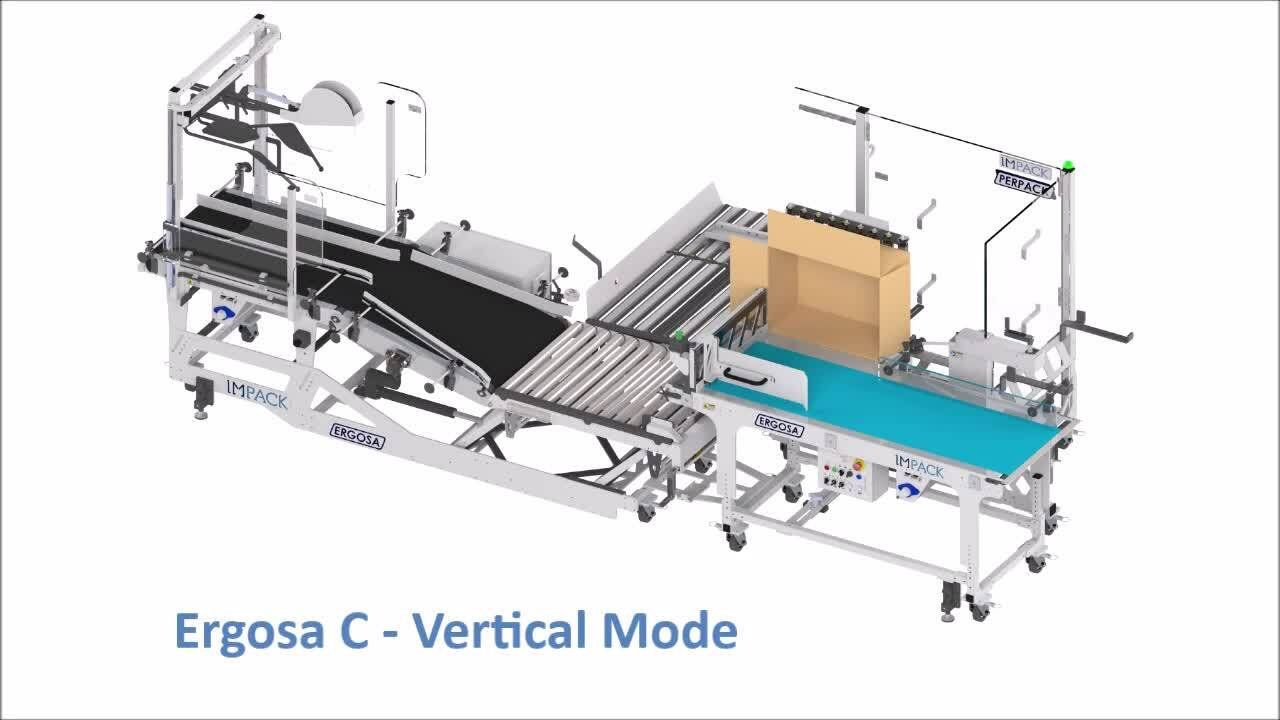
It is important for you to know that although the Semi-Automated packing process is the next level of automation right above the Manual packing process, the difference between a Manual packing process and a Semi-Automated packing process is astronomical.
If you’re curious about how a Semi-Automatic packer compares to a typical Collecting Table, compare them against each other by reading “What's the Difference between Collecting Tables and the Ergosa Packer?”
🔍 Recommended:
Interested in learning more about IMPACK’s Ergosa packer? Check out the article “What is the Ergosa Packer & What Companies Is It Best Suited For?”
Curious about how a Manual packing process compares to a Semi-Automated packing process? Discover the differences by reading “What's the Difference between Collecting Tables and the Ergosa Packer?”
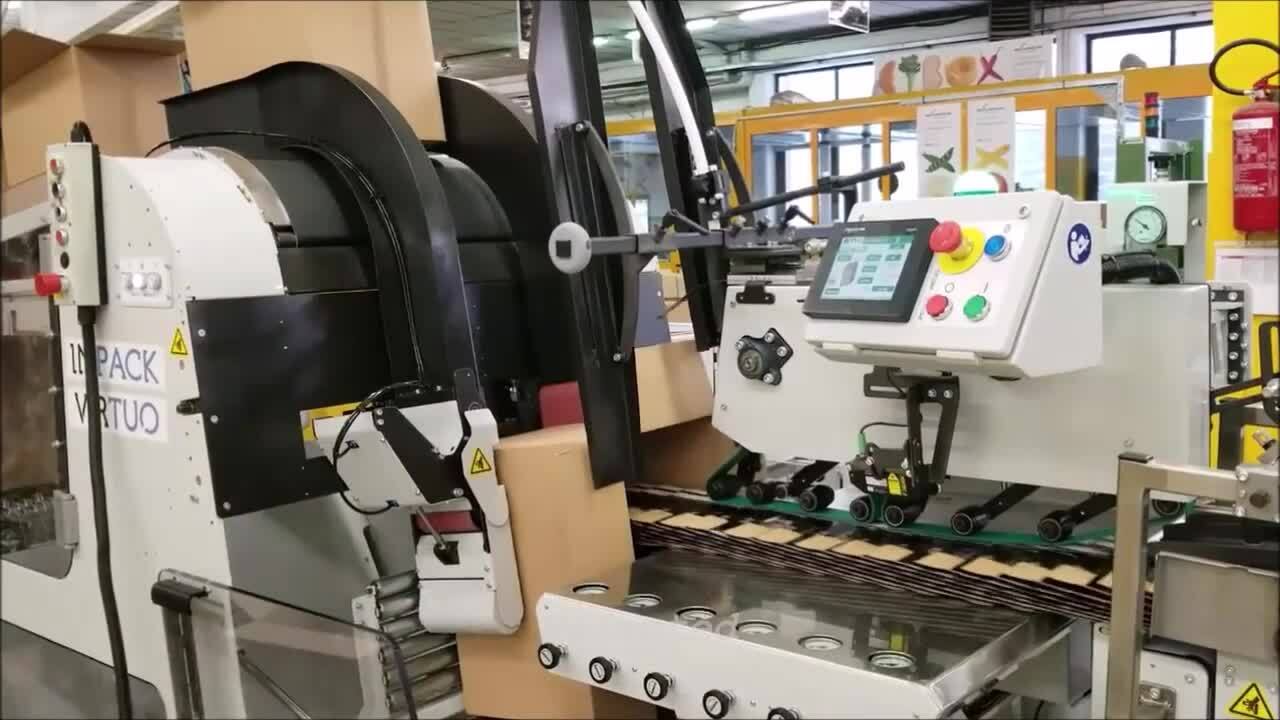
Automated packing is a packing process that includes multiple automated functions.
In an Automated packing process, the machine becomes the key factor of the packing process and the operator is now limited to only performing background tasks such as feeding the packer with empty cases or managing full cases.
That said, and just like with a Semi-Automatic packer, the operator is still permanently present as part of the Automated packing process and is required to operate the Automatic packer.
However, and unlike the Semi-Automatic packer, the Automatic packer offers a more Automated packing process with greater performance but less versatility.
In short, Automated packing is the next level of automation above Semi-Automated packing and just below Fully-Automated packing. It automates your case packing process up to a point, but a human is still required to be present (although they are no longer performing primary tasks and are limited to background tasks).
IMPACK’s Automatic packer is the Virtuo packer.
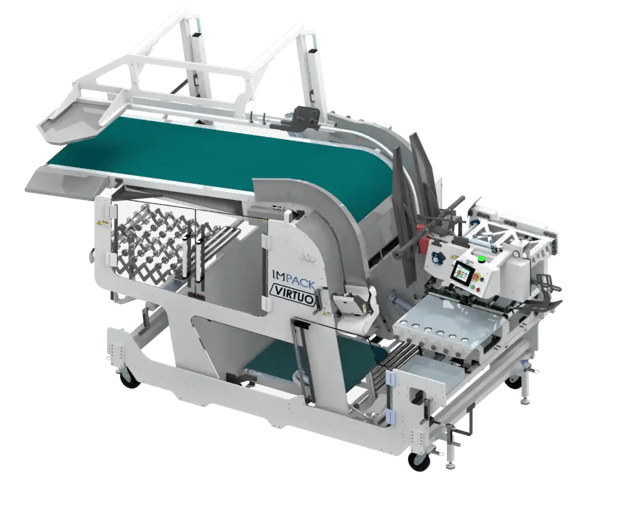
Bobst’s CartonPack 4, Heidelberg’s Diana Packer, WSI Global’s Express Pack, and Graphic West Packaging’s J-Pack are some examples of the most popular Automatic packers in Western countries.
🔍 Recommended: Interested in learning more about IMPACK’s Virtuo packer? Read the article “What is the Virtuo Packer & What Companies is it Best Suited For?”
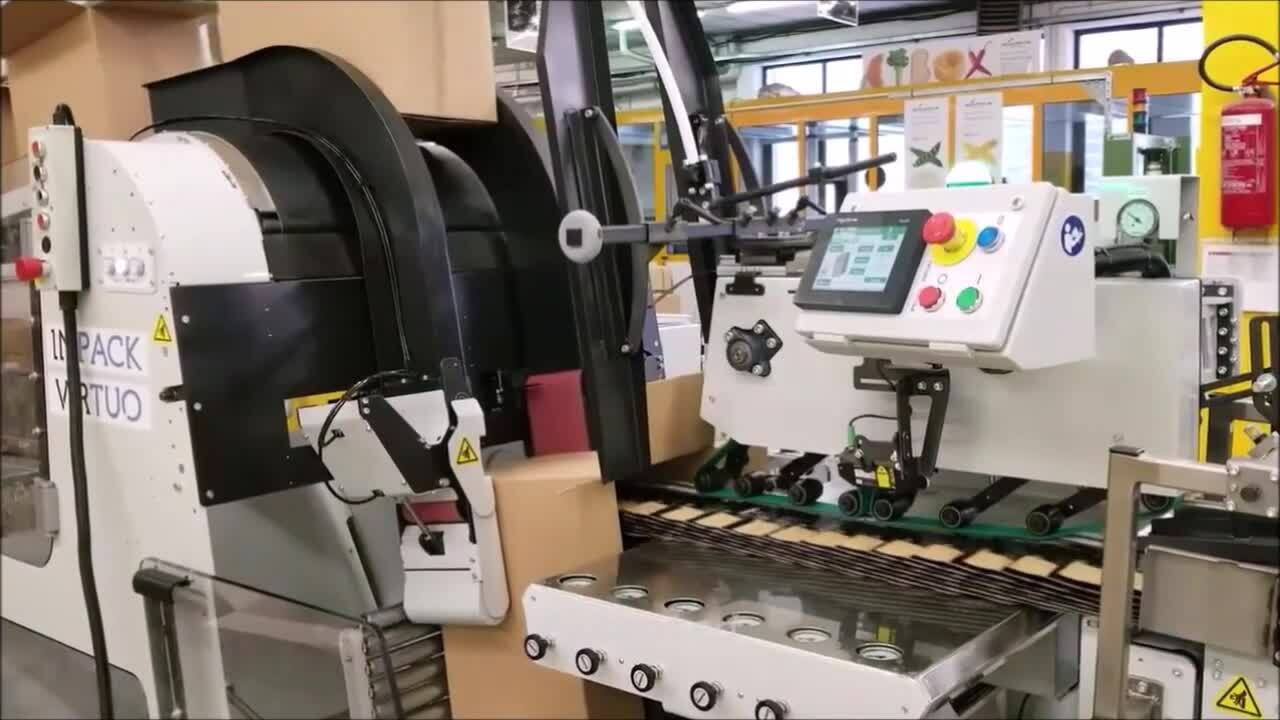
This is the “holy grail” of automation, where everything runs by itself — quite literally.
Fully-Automated packing offers the highest possible level of automation.
A Fully-Automatic packer automates your entire case packing process so that your operator is no longer required to be present.
That is, your case packing process becomes 100% automated with zero human intervention.
Upgrading to a Fully-Automated process would mean automating what the human was previously doing in the Automated process which is to place the empty cases into the machine.
A Fully-Automatic packer feeds itself with empty cases, manages the filled cases, and seals the filled cases fully automatically without requiring the presence of an operator (or any other humans) while running.
The operator is only ever involved during setups and adjustments. But once the machine is set up and running, the operator can move on to higher value-added activities.
When it comes to comparing Manual packers, Semi-Automatic packers, Automatic packers, and Fully-Automatic packers, Fully-Automatic packers are easily the most tempting option that clients want.
However, it is also more complex, more expensive, and more technical.
But, for some companies, a Fully-Automatic packer is the most practical option that makes sense for their folder-gluer production.
IMPACK’s Fully-Automatic packer is the “Virtuo + ACF.”
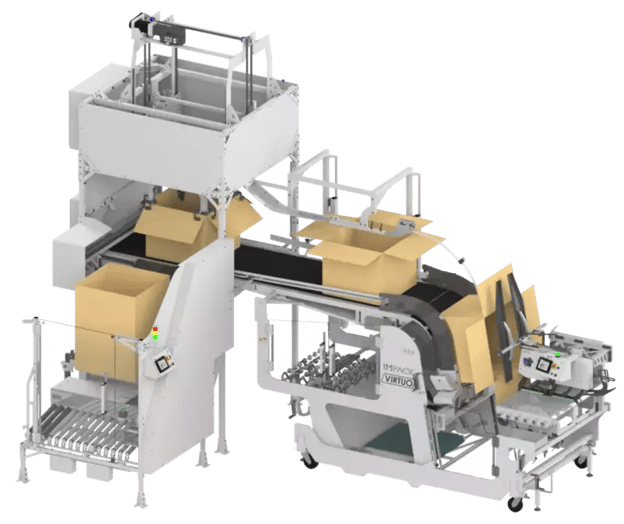
IMPACK’s Virtuo + ACF, Bobst’s Carton Pack 4 + optional case erector, WSI Global's ExpressPack + optional case erector, and CSI Packaging’s I-Pack are some examples of the most popular Fully-Automatic packers in Western countries.
🔍 Recommended: If you’re interested in learning more about IMPACK’s Virtuo + ACF, the article “How to Further Automate Your Virtuo Packer: Virtuo and ACF Combination” covers everything you need to know about the Virtuo + ACF!
Time for some complete and raw honesty:
A lot of clients get very excited when companies propose and discuss Automatic and Fully-Automatic packers.
And it can be an easy sale for us, packaging equipment suppliers, driven by the client’s pure temptation of having a robot doing the whole job, but that’s the perception in theory.
In practice, things are very different, and we want to make sure that you’re aware of this before you commit to any packaging equipment supplier.
I mean...having a robot fully automate your entire case packing process would be like hitting the jackpot, but that’s far from the reality.
Here’s the truth that most suppliers don’t want you to know: A Fully-Automatic packer is far more expensive than a Semi-Automatic packer or an Automatic packer and it won’t make you go faster than an Automatic packer.
Why?
A Fully-Automated process is one step above an Automated process. And in a Fully-Automated process, you are, in essence, automating the human that simply used to put empty cases into the machine.
This operator was never really a bottleneck, so the folder-gluer packer would never be limited by this person who’s simply putting empty cases into the machine.
The folder-gluer packer was already doing everything else automatically in the Automated process and removing that operator who simply fills the cases won’t make you go any faster.
You would run at the exact same speed but with better efficiency.
So, here’s an interesting question for you:
If the operator is required for the operation of an Automatic packer – just like they are with a Semi-Automatic packer – and you’re capable of reaching the same speed with a Semi-Automatic packer as you would with an Automatic packer, why pay a higher price for an Automatic packer?
Taking it a step further: If a Fully-Automatic packer runs at the same speed as an Automatic packer and all you’re doing is automating the human that used to fill the packer with empty cases, is automating that human worth the extra cost?
There is no packer on the market that can fully copy a human’s hand movements. It is so natural for a human to pick up a box out of the shingle when there’s a problem.
And admittedly, it’s just as easy to fancy the thought of automating the hand movements of an operator, but when you start thinking about the mechanics involved, you’re hit with the unfortunate realization that it’s virtually impossible for a robot to copy all those natural human movements.
You can argue that there are fully automated robots for palletizing that can imitate most of a human’s movement, and that is undeniably correct.
But it’s important for you to know that with those projects, the scope is very clearly defined, always the same, never changing, and always accurate and perfect.
What happens if a slight modification is needed?
The robot completely fails.
But a human will just adapt: There’s a box sticking out or pushed forward…a human can just fix it with their own hands.
You just cannot automate every action a human does.
We organize everything around the folder-gluer packer so that the process is as automated and efficient as possible, but we rely on the human to make it possible.
You can certainly attempt to imitate a lot of those human movements through automation, just like you can launch a spacecraft to Mars, but the question is: At what cost are you willing to do so?
Would you be willing to pay millions of dollars for a machine that is fully automated and perfectly dedicated with zero margin for error but yet has a complete lack of forgiveness towards modifications?
This is where realism must be integrated into your decision-making process: There’s always going to be a tradeoff between versatility and performance.
You cannot have the versatility of a Semi-Automatic packer with an Automatic or Fully-Automatic packer, but you can reach the performance of an Automatic packer with a Semi-Automatic packer: A critical point to acknowledge.
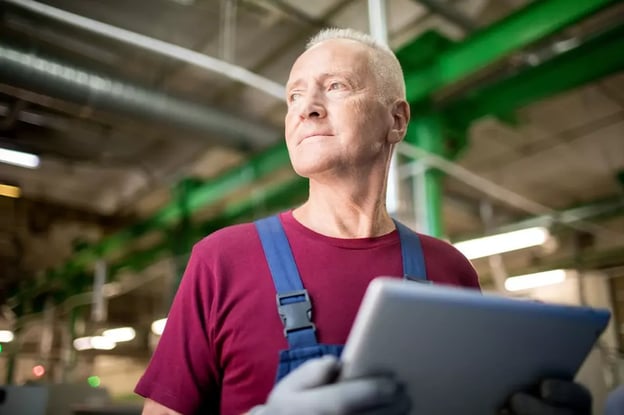
Now that you have a better understanding of the 4 different levels of automation, it is time for you to determine the right level of automation and the best machine for your company’s production and budget.
This will allow you to have a detailed breakdown of how much this machine would cost you.
You never had a packer or any packing help/aid before
You want to take your first step towards improving your folder-gluer productivity
You’re not sure of your production and have a very tight budget
You have complex boxes that require constant adjustments or quality control checks
You have very limited floor space
If your production meets several of the characteristics described above, and you’ve never had any “packing help” or “packing aid,” then Manual packing could be a great start and Collecting Tables would be the right fit for your production.
Examples of the most popular Collecting Tables jnm in the Western market include: IMPACK’s Packing Help Stations, Bobst’s Handypack GT, KBA Duran's Omega Pack Station, and Tünkers' FAS 480.
You have variable production runs
You have small to medium-sized boxes
You have a wide and diverse variety of box formats
You have complex boxes that require constant adjustments or quality control checks
Here, Semi-Automated packing is the right level of automation and a Semi-Automatic packer could be the perfect solution for your company.
IMPACK’s Ergosa packer is our top sold machine and one of the only Semi-Automatic packers that exists, to date, on the market.
You have long production runs
You have medium to very large-sized boxes
You have a limited variety and similar box formats
You have simpler boxes that do not need constant adjustments or quality control checks
Here, Automated packing is the right level of automation and an Automatic packer would be the best fit.
Examples of the most popular Automatic packers in the Western market include: IMPACK’s Virtuo packer, Bobst’s CartonPack 4, Heidelberg’s Diana Packer, WSI Global’s ExpressPack, and Graphic West Packaging’s J-Pack.
You have all the Automatic packer requirements listed above
You want to fully automate your packing process
You want to reach a zero-human operation (no humans involved)
You're interested in advanced monitoring and industry 4.0 functionalities
Here, Fully-Automated packing is the right level of automation and a Fully-Automatic packer would be the ideal option.
Examples of the most popular Fully-Automatic packers in the Western market include:
IMPACK’s Virtuo + ACF, Bobst’s Carton Pack 4 + optional case erector, WSI’s ExpressPack + optional case erector, and CSI Packaging’s I-Pack.
Still unsure on what level of automation is right for your folder-gluer’s production? No problem! Book an Appointment with an IMPACK Expert and we’ll offer you a FREE production analysis to help you determine the right level of automation & the best machine for your production 😉.
Wondering how much an IMPACK machine could cost you? Get a detailed breakdown on cost by checking out: How Much Does a Folder-Gluer Packer Cost?
And finally, if you’re conflicted about which IMPACK machine is right for your company, compare IMPACK’s 3 main machines “Ergosa Vs. Virtuo Vs. Everio” to discover which machine is right for you
![What is a Semi-Automatic Packer and How Can It Improve My Packing Process? [+ VIDEO]](https://impack.ca/hubfs/X21-057.png)
If you’re looking for ways to improve your folder-gluer’s productivity, increase your folder-gluer’s output, and reach higher speeds, you’re probably...

You and your competitors have 1 common goal:

Are you looking for a packing system to help you improve your folder-gluer’s productivity, increase your folder-gluer’s output, and reach top packing...